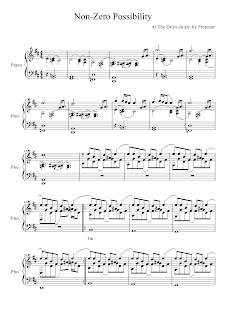





this hex was delivered spent: When I first started listening to At The Drive-In five years ago, I liked them because I thought the vocal style was similar to the one of Rage Against The Machine’s Zack de la Rocha: This was like Rage Against The Machine with a melody! I bought Relationship Of Command and it was only after some time that I started to discover the many layers within the songs and the unique aesthetics of At The Drive-In’s songwriting; there was something always a bit “off” about the melodies and riffs, making them sound at the same time familiar, but with a certain edge to it that I had never heard in any other band. Only much later when I started playing some of their stuff on guitar, I discovered what I believe to be the reason for this; at first I thought of At The Drive-In as the “neoclassicists” of rock music, as we had recently learned in school about neoclassicism in classical music. One of the principles to be found for example in P. Hindemith’s music was the so-called “emancipation of the interval”, meaning that an interval could now be a characteristic feature that was elaborated on, largely unfettered by harmonic limitations. Thus you find a characteristic motive that seems familiar itself, but is contrasted and combined with other melodic lines in ways that appear unusual to our ears. A successful concept indeed that can be applied to many areas: recently I went to a rather successful modern-style Korean restaurant and I found the grilled meat to be just familiar enough to be easily enjoyable, yet some other ingredients gave it the certain edge that turned it into something special. At The Drive-In’s music is similar: In songs like Pattern Against User or One-Armed Scissor we hear guitar licks that are very close to what we are used to while contrasting them with chords that you will not find in any guitar book, using lots of open strings or handy fingerings. The result is what I like to call the “Gestalt effect” of music. I am not an expert on Gestalt psychology, but just to get an idea take a look at the picture.

You will probably see a white triangle, even though the visual information consists only of three incomplete circles: Due to its organizing qualities, our brain tends to structure information into patterns that make sense, deliberately completing the picture into something familiar. The phenomenon is sometimes referred to as “a whole being greater than the sum of its parts”. Again, very true concerning the music of At The Drive-In. When I first started playing it on guitar I was rather disappointed by the “parts”: What I played sounded disharmonious and not nearly as awesome as the riff that blasted from the speakers. Were the tabs wrong? No, this was definitely the way of playing it, I could tell that. So it turns out that many of At The Drive-In’s awesome melodies, riffs, licks etc. are a “great whole”. This is not unusual in every kind of music of course, as a combination of voices almost universally creates a richer texture. What is special about At The Drive-In then, is that much of their music sounds totally DIFFERENT when one part is played alone or just at a different speed than usual. So in the first place, the music creates a new “Gestalt effect” as soon as it reaches a certain tempo which is pretty amazing and not at all common in rock music; I can think of an example in classical music though – if you listen to G. Gould’s performance (very slow) of the first movement of Beethoven’s Appassionata Sonata and compare it to any other performance of that piece, you will know what I mean. Yet, this is not where At The Drive-In’s awesomeness ends. I have repeatedly noticed that my brain tricked my into believing I was hearing certain melodic shapes in At The Drive-In’s songs, only to find on a closer listening that they were absolutely NOT THERE. For example, I always perceived the melodic contour of the phrase “This hex was delivered spent” as being arched, until I transcribed the song and realized that the melody was rather moving back and forth between two notes. Now what is so awesome about all this is that while I may understand how a Gestalt effect can take place in music I find it hard to imagine how you can possibly put it there on purpose. And there are so many examples that it rules out a mere coincidence. So even though I mostly listen to music other than rock nowadays, this is why At The Drive-In will always be up there among my top five favorite rock bands.

1 Kommentar:
Max Wertheimer hätte seine Freude an Bibigo.. ;)
Kommentar veröffentlichen